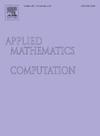(弱-)反强有向图的经典条件
IF 3.4
2区 数学
Q1 MATHEMATICS, APPLIED
引用次数: 0
摘要
有向图中的反向轨迹是弧在向前和向后之间交替运动的轨迹。特别地,一个反向轨迹被归类为一个正向反向轨迹,如果它开始和结束于一个正向弧。有向图D有n个顶点(其中n≥3),当对V(D)中的任意一对顶点p和q存在从p到q的正向反向轨迹时称为反强。另外,当对V(D)中的任意一对顶点p和q存在正向反向(p,q)轨迹或正向反向(p,q)轨迹时,则有向图D是弱反强的。本文给出了有向图(弱)-反强的程度和条件,优于Yuan(2023)给出的矿型条件。另外给出了二部有向图是弱反强的充分必要条件,以及传递有向图和全有向图是反强的充分必要条件。进一步给出了有向图反强的一个弧数条件。本文章由计算机程序翻译,如有差异,请以英文原文为准。
Classical conditions for (weakly-)antistrong digraphs
An antidirected trail in a digraph is one where the arcs alternate between moving forward and backward. In particular, an antidirected trail is categorized as a forward antidirected trail if it begins and ends with a forward arc. A digraph D with n vertices (where ) is termed antistrong if, for any pair of vertices p and q in , there exists a forward antidirected trail from p to q. Additionally, a digraph D is weakly-antistrong if, for any pair of vertices p and q in , there exists either a forward-backward antidirected -trail or a forward antidirected -trail. In this study, we provide a degree sum condition for digraphs to be (weakly)-antistrong, which is superior to the ore-type condition given by Yuan (2023). We additionally present necessary and sufficient condition for bipartite digraphs to qualify as weakly-antistrong, and necessary and sufficient conditions for transitive digraphs and total digraphs to be antistrong. Furthermore, we give an arc number condition for digraphs to be antistrong.
求助全文
通过发布文献求助,成功后即可免费获取论文全文。
去求助
来源期刊
CiteScore
7.90
自引率
10.00%
发文量
755
审稿时长
36 days
期刊介绍:
Applied Mathematics and Computation addresses work at the interface between applied mathematics, numerical computation, and applications of systems – oriented ideas to the physical, biological, social, and behavioral sciences, and emphasizes papers of a computational nature focusing on new algorithms, their analysis and numerical results.
In addition to presenting research papers, Applied Mathematics and Computation publishes review articles and single–topics issues.

 求助内容:
求助内容: 应助结果提醒方式:
应助结果提醒方式:


